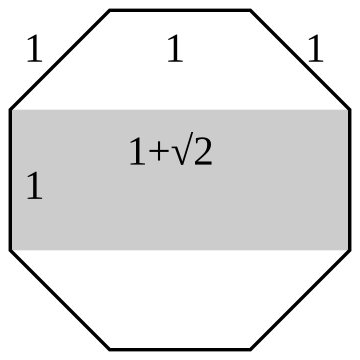In mathematics, two quantities are in the silver ratio (or silver mean)[1][2] if the ratio of the larger of those two quantities to the smaller quantity is the same as the ratio of the sum of the smaller quantity plus twice the larger quantity to the larger quantity (see below). This defines the silver ratio as an irrational mathematical constant, whose value of one plus the square root of 2 is approximately 2.4142135623. Its name is an allusion to the golden ratio; analogously to the way the golden ratio is the limiting ratio of consecutive Fibonacci numbers, the silver ratio is the limiting ratio of consecutive Pell numbers. The silver ratio is sometimes denoted by δS but it can vary from λ to σ.
This article needs additional citations for verification. (April 2016) |
Mathematicians have studied the silver ratio since the time of the Greeks (although perhaps without giving a special name until recently) because of its connections to the square root of 2, its convergents, square triangular numbers, Pell numbers, octagons and the like.
The relation described above can be expressed algebraically, for a > b:
or equivalently,
The silver ratio can also be defined by the simple continued fraction [2; 2, 2, 2, ...]:
The convergents of this continued fraction (2/1, 5/2, 12/5, 29/12, 70/29, ...) are ratios of consecutive Pell numbers. These fractions provide accurate rational approximations of the silver ratio, analogous to the approximation of the golden ratio by ratios of consecutive Fibonacci numbers.

The silver rectangle is connected to the regular octagon. If a regular octagon is partitioned into two isosceles trapezoids and a rectangle, then the rectangle is a silver rectangle with an aspect ratio of 1:δS, and the 4 sides of the trapezoids are in a ratio of 1:1:1:δS. If the edge length of a regular octagon is t, then the span of the octagon (the distance between opposite sides) is δSt, and the area of the octagon is 2δSt2.[3]
Calculation
For comparison, two quantities a, b with a > b > 0 are said to be in the golden ratio φ if,
However, they are in the silver ratio δS if,
Equivalently,
Therefore,
Multiplying by δS and rearranging gives
Using the quadratic formula, two solutions can be obtained. Because δS is the ratio of positive quantities, it is necessarily positive, so,
Properties


Other than the silver rectangle, the silver ratio is also related to the regular Octagon, and the following 3D shapes:
1.Truncated cube
2.Deltoidal icositetrahedron
3.Rhombic cuboctahedron
Number-theoretic properties
The silver ratio is a Pisot–Vijayaraghavan number (PV number), as its conjugate 1 − √2 = −1/δS ≈ −0.41421 has absolute value less than 1. In fact it is the second smallest quadratic PV number after the golden ratio. This means the distance from δ n
S to the nearest integer is 1/δ n
S ≈ 0.41421n. Thus, the sequence of fractional parts of δ n
S, n = 1, 2, 3, ... (taken as elements of the torus) converges. In particular, this sequence is not equidistributed mod 1.
Powers
The lower powers of the silver ratio are
The powers continue in the pattern
where
For example, using this property:
Using K0 = 1 and K1 = 2 as initial conditions, a Binet-like formula results from solving the recurrence relation
which becomes
Trigonometric properties
The silver ratio is intimately connected to trigonometric ratios for π/8 = 22.5°.
So the area of a regular octagon with side length a is given by
In the function: The Range of the function is :
- cos (2tan-1δS) - sin (2 tan-1 δS) ≤ y ≤ cos (2 tan-1 −1/δS ) - sin (2 tan-1 −1/δS)
For all real numbers, x.
See also
References
Further reading
External links
Wikiwand in your browser!
Seamless Wikipedia browsing. On steroids.
Every time you click a link to Wikipedia, Wiktionary or Wikiquote in your browser's search results, it will show the modern Wikiwand interface.
Wikiwand extension is a five stars, simple, with minimum permission required to keep your browsing private, safe and transparent.











![{\displaystyle \delta _{S}^{-1}=1\delta _{S}-2=[0;2,2,2,2,2,\dots ]\approx 0.41421}](http://wikimedia.org/api/rest_v1/media/math/render/svg/6b990f8c24f259f20e790b19bc7a0964ffca4856)
![{\displaystyle \delta _{S}^{0}=0\delta _{S}+1=[1]=1}](http://wikimedia.org/api/rest_v1/media/math/render/svg/a3f43698a8899ad582f4858848f9a3128e6bc7c0)
![{\displaystyle \delta _{S}^{1}=1\delta _{S}+0=[2;2,2,2,2,2,\dots ]\approx 2.41421}](http://wikimedia.org/api/rest_v1/media/math/render/svg/246db5a8c15bcfe70b7e8097f24316e50622feb3)
![{\displaystyle \delta _{S}^{2}=2\delta _{S}+1=[5;1,4,1,4,1,\dots ]\approx 5.82842}](http://wikimedia.org/api/rest_v1/media/math/render/svg/f21030c1b14c77c31ad8abb6aacd680e678fbbac)
![{\displaystyle \delta _{S}^{3}=5\delta _{S}+2=[14;14,14,14,\dots ]\approx 14.07107}](http://wikimedia.org/api/rest_v1/media/math/render/svg/7a027dc6a0219d4911b34b55f89eb6be29eb4a01)
![{\displaystyle \delta _{S}^{4}=12\delta _{S}+5=[33;1,32,1,32,\dots ]\approx 33.97056}](http://wikimedia.org/api/rest_v1/media/math/render/svg/a8048daeeaf27de5d7ca01933e4f756099aec1e2)


![{\displaystyle \delta _{S}^{5}=29\delta _{S}+12=[82;82,82,82,\dots ]\approx 82.01219}](http://wikimedia.org/api/rest_v1/media/math/render/svg/dc4032d19efdd0c8dfea44966c3f25ef2c19e510)





